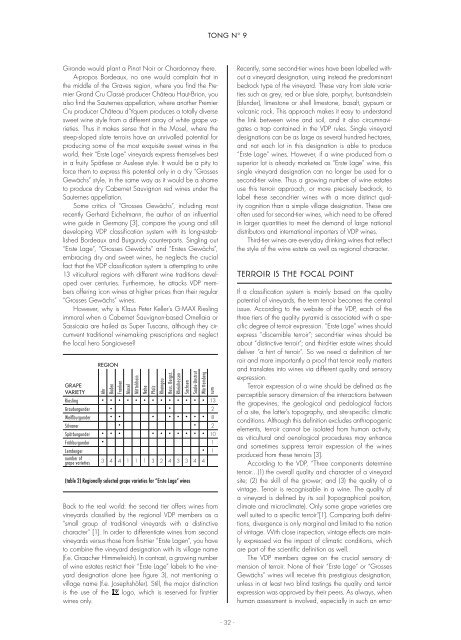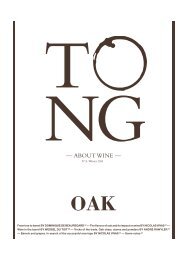here - Tong Magazine
here - Tong Magazine
here - Tong Magazine
- No tags were found...
You also want an ePaper? Increase the reach of your titles
YUMPU automatically turns print PDFs into web optimized ePapers that Google loves.
TONG N° 9Gironde would plant a Pinot Noir or Chardonnay t<strong>here</strong>.A-propos Bordeaux, no one would complain that inthe middle of the Graves region, w<strong>here</strong> you find the PremierGrand Cru Classé producer Château Haut-Brion, youalso find the Sauternes appellation, w<strong>here</strong> another PremierCru producer Château d’Yquem produces a totally diversesweet wine style from a different array of white grape varieties.Thus it makes sense that in the Mosel, w<strong>here</strong> thesteep-sloped slate terroirs have an unrivalled potential forproducing some of the most exquisite sweet wines in theworld, their “Erste Lage” vineyards express themselves bestin a fruity Spätlese or Auslese style. It would be a pity toforce them to express this potential only in a dry “GrossesGewächs” style, in the same way as it would be a shameto produce dry Cabernet Sauvignon red wines under theSauternes appellation.Some critics of “Grosses Gewächs”, including mostrecently Gerhard Eichelmann, the author of an influentialwine guide in Germany [3], compare the young and stilldeveloping VDP classification system with its long-establishedBordeaux and Burgundy counterparts. Singling out“Erste Lage”, “Grosses Gewächs” and “Erstes Gewächs”,embracing dry and sweet wines, he neglects the crucialfact that the VDP classification system is attempting to unite13 viticultural regions with different wine traditions developedover centuries. Furthermore, he attacks VDP membersoffering icon wines at higher prices than their regular“Grosses Gewächs” wines.However, why is Klaus Peter Keller’s G-MAX Rieslingimmoral when a Cabernet Sauvignon-based Ornellaia orSassicaia are hailed as Super Tuscans, although they circumventtraditional winemaking prescriptions and neglectthe local hero Sangiovese?If a classification system is mainly based on the qualitypotential of vineyards, the term terroir becomes the centralissue. According to the website of the VDP, each of thethree tiers of the quality pyramid is associated with a specificdegree of terroir expression. “Erste Lage” wines shouldexpress “discernible terroir”; second-tier wines should beabout “distinctive terroir”; and third-tier estate wines shoulddeliver “a hint of terroir”. So we need a definition of terroirand more importantly a proof that terroir really mattersand translates into wines via different quality and sensoryexpression.Terroir expression of a wine should be defined as theperceptible sensory dimension of the interactions betweenthe grapevines, the geological and pedological factorsof a site, the latter’s topography, and site-specific climaticconditions. Although this definition excludes anthropogenicelements, terroir cannot be isolated from human activity,as viticultural and oenological procedures may enhanceand sometimes suppress terroir expression of the winesproduced from these terroirs [3].According to the VDP, “Three components determineterroir…(1) the overall quality and character of a vineyardsite; (2) the skill of the grower; and (3) the quality of avintage. Terroir is recognisable in a wine. The quality ofa vineyard is defined by its soil (topographical position,climate and microclimate). Only some grape varieties arewell suited to a specific terroir”[1]. Comparing both definitions,divergence is only marginal and limited to the notionof vintage. With close inspection, vintage effects are mainlyexpressed via the impact of climatic conditions, whichare part of the scientific definition as well.The VDP members agree on the crucial sensory dimensionof terroir. None of their “Erste Lage” or “GrossesGewächs” wines will receive this prestigious designation,unless in at least two blind tastings the quality and terroirexpression was approved by their peers. As always, whenhuman assessment is involved, especially in such an emoregionAhrBadenFrankenMoselMittelrheinNahePfalzRheingauHess. Bergst.RheinhessenSachsenSaale-UnstrutWürttembergsumgrapevarietyRiesling • • • • • • • • • • • • • 13Grauburgunder • • 2Weißburgunder • • • • • • • • 8Silvaner • • 2Spätburgunder • • • • • • • • • • 10Frühburgunder • 1Lemberger • 1number ofgrape varieties 3 4 4 1 1 1 3 2 4 3 3 4 4(table 2) Regionally selected grape varieties for “Erste Lage” winesBack to the real world: the second tier offers wines fromvineyards classified by the regional VDP members as a“small group of traditional vineyards with a distinctivecharacter” [1]. In order to differentiate wines from secondvineyards versus those from first-tier “Erste Lagen”, you haveto combine the vineyard designation with its village name(f.e. Graacher Himmelreich). In contrast, a growing numberof wine estates restrict their “Erste Lage” labels to the vineyarddesignation alone (see figure 3), not mentioning avillage name (f.e. Josephshöfer). Still, the major distinctionis the use of the logo, which is reserved for first-tierwines only.Recently, some second-tier wines have been labelled withouta vineyard designation, using instead the predominantbedrock type of the vineyard. These vary from slate varietiessuch as grey, red or blue slate, porphyr, buntsandstein(blunder), limestone or shell limestone, basalt, gypsum orvolcanic rock. This approach makes it easy to understandthe link between wine and soil, and it also circumnavigatesa trap contained in the VDP rules. Single vineyarddesignations can be as large as several hundred hectares,and not each lot in this designation is able to produce“Erste Lage” wines. However, if a wine produced from asuperior lot is already marketed as “Erste Lage” wine, thissingle vineyard designation can no longer be used for asecond-tier wine. Thus a growing number of wine estatesuse this terroir approach, or more precisely bedrock, tolabel these second-tier wines with a more distinct qualitycognition than a simple village designation. These areoften used for second-tier wines, which need to be offeredin larger quantities to meet the demand of large nationaldistributors and international importers of VDP wines.Third-tier wines are everyday drinking wines that reflectthe style of the wine estate as well as regional character.Terroir is the focal point- 32 -





